Research Article - (2024) Volume 25, Issue 6
Received: 19-Sep-2024, Manuscript No. IPP-24-22035; Editor assigned: 24-Sep-2024, Pre QC No. IPP-24-22035 (PQ); Reviewed: 08-Oct-2024, QC No. IPP-24-22035; Revised: 15-Nov-2024, Manuscript No. IPP-24-22035 (R); Published: 13-Dec-2024, DOI: 10.35841/1590-8577-24.6.893
Pancreatic injuries following blunt abdomen trauma is a rare and potentially life-threatening occurrence. Pancreatic trauma is often missed on the initial clinical examination and ultrasound done for trauma as it is a retroperitoneal organ. Additionally, injury to the pancreas initially may be silent with just mild abdominal discomfort and later can present as necrotising pancreatitis, pancreatic ascites, pseudocyst, abscesses, fistulae, pseudoaneurysm rupture with hemoperitoneum etc which becomes challenging for the clinician to manage. Management of pancreatic injuries are still a challenge to surgeons as surgically intervention in these cases can be lifesaving or lead to more damage.
Abdomen trauma; Abscesses; Fistulae; Pseudoaneurysm rupture
A patient with blunt pancreatic injury was first reported in The Lancet as early as 1827, by Tavers [1]. Pancreatic trauma at that point in time posed a high level of morbidity and mortality. The major advance in the operative treatment came in 1923, when Walton described distal pancreatectomy as the treatment of choice for pancreatic duct transection [1].
The age of adage of “Eat when you can, sleep when you can and don’t mess with the pancreas" is universally known because of morbidity associated with pancreatic complications. We are now looking at the cases where the pancreas is already trifled with. The patients with pancreatic trauma have a wide clinical spectrum ranging from asymptomatic patients to mild epigastric pain to patients with peritonitis and Multi-Organ Dysfunction (MODS). Pancreatic injury is rare as it has been reported to occur as low as 0.2% to 1.1% of all trauma cases. Isolated pancreatic trauma is seen in only 30% of these cases and only 5% of these cases are related to fatal outcomes [2].
In majority of the cases the pancreatic injury is associated with polytraumatic injury for which the management of the patient necessitates exploration. In the final decades of the last century, advances in medical imaging and in surgical technique converged to improve the care of patients with pancreatic trauma. The most important of these was Computed Tomography (CT) of the abdomen which for the first time allowed detailed visualisation of the pancreas [3]. This enabled surgeons to diagnose previously unrecognised pancreatic injuries and to drain peripancreatic fluid collections without the need for a laparotomy.
This descriptive retrospective study includes all adult cases with isolated pancreatic injury following blunt trauma in the General Surgery Department in a tertiary care hospital during three years (Jan 2021 to Jan 2024).
Due clearance for study from institutional ethics committee was taken. There were 5 cases managed with pancreatic injury with conservative or surgical treatment and the age range was 12-94 years. Diagnosis was made by detailed history, physical examination, abdominal X-ray, Ultrasonography, CECT and MRCP and blood investigations. A special data collection sheet designed to collect data regarding the diagnosis, age and sex from the profile of patients retrospectively. Data entry was performed by using Microsoft Excel.
Observations
From the hospital case record, a total of five cases were identified in the duration of three years from January 2022 to Jan 2024. The mean age of patients was 21 years (14-34 years). The male to female ratio was 4:1. A history of blunt trauma to the abdomen was present in all the patients.
Evaluation: All patients underwent trauma evaluation while concurrent resuscitative measures were taken. Out of the 5 patients 3 (66.67%) patients presented with decompensated hemodynamic status. Of the 3 patients, two patients had hypovolemic shock because of haemorrhage while the third patient presented in septic shock. After initial resuscitation the patients underwent CECT (Contrast Enhanced Computed Tomography) to obtain a more detailed injury grading through AAST-OIS (Organ Injury Scale) (Table 1).
| Sr. No | Age (Yrs) | Sex | History/Mode of trauma | Duration of symptoms | Grade of injury | Hemodynamic status at first contact | Management | Complication |
|---|---|---|---|---|---|---|---|---|
| 1 | 17 | M | Blunt trauma to abdomen with bull horn | 17 days | 3 | Septic shock | Percutaneous drainage followed by ductojejunostomy | Peripancreatic collection |
| 2 | 14 | M | Blunt trauma to the abdomen with wooden bench | 8 months | 2 | Vitally stable | Conservatively with ERCP stenting followed by VATS guided decortication | Pancreatico-pleural fistula |
| 3 | 14 | M | Blunt trauma with bicycle | 15 days | 4 | Vitally stable | Conservatively with ERCP stenting | NA |
| 4 | 28 | F | Blunt trauma | 1 day | 3 | Hypovolemic shock | Distal pancreatectomy with splenectomy | NA |
| 5 | 34 | M | Blunt trauma | 2 days | 3 | Hypovolemic shock | Distal pancreatectomy with splenectomy | NA |
Table 1. Patient data.
The grading of patients was done according to the AAST grading of organ injury scale, of the five patients one patient had grade 4 injuries, one patient had grade 2 injuries and three patients had grade three injury (Figures 1 and 2).
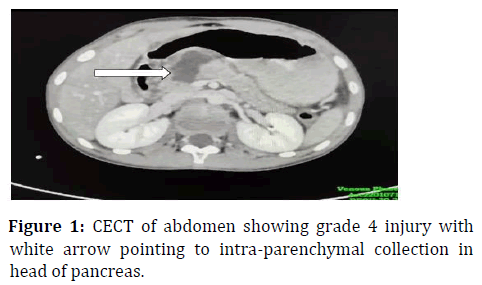
Figure 1: CECT of abdomen showing grade 4 injury with white arrow pointing to intra-parenchymal collection in head of pancreas.
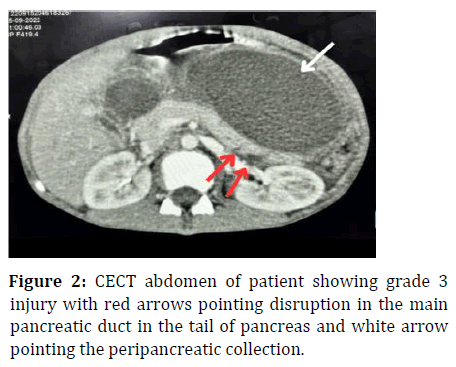
Figure 2: CECT abdomen of patient showing grade 3 injury with red arrows pointing disruption in the main pancreatic duct in the tail of pancreas and white arrow pointing the peripancreatic collection.
Management
Three (60%) out of the five patients required operative intervention whereas two (40%) of the patients were conservatively managed. Of the patients requiring surgical intervention all of them had grade three injuries. Surgical procedure done for patients with massive disruption of the main pancreatic duct (grade 3 injury) was distal pancreatectomy and splenectomy in two cases and one patient with grade 3 pancreatic injury and peripancreatic collection was treated with initial percutaneous drainage of the peripancreatic collection followed by ancreaticojejunostomy without pancreatic or splenic resection (Figures 3 and 4).
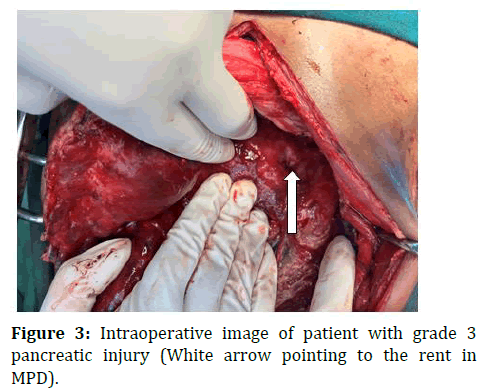
Figure 3: Intraoperative image of patient with grade 3 pancreatic injury (White arrow pointing to the rent in MPD).
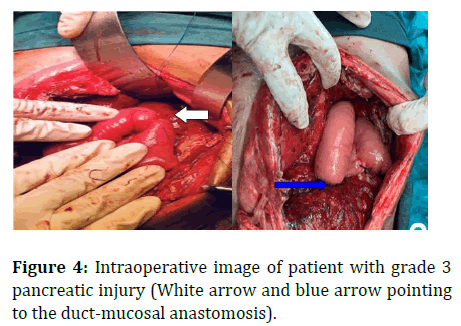
Figure 4: Intraoperative image of patient with grade 3 pancreatic injury (White arrow and blue arrow pointing to the duct-mucosal anastomosis).
Complications
Two (40%) of the five patients had complications. The complications were seen in both sets of patients that were managed conservatively as well the one requiring surgical complication. The complications include peripancreatic collection and pancreaticopleural fistula. The peripancreatic collection was dealt with both via percutaneous drainage as well as intraoperative drainage.
The patient pancreaticopleural fistula was diagnosed on MRCP (Figure 5). Patient underwent ERCP guided stenting with thoracocentesis for pleural effusion. However due to long standing pleural effusion there were adhesions in pleural effusion preventing lung expansion. Hence patient required VATS guided decortication for optimum outcome.
The patients were followed up for 6 months after discharge. They were assessed clinically and radiologically. The pain was assessed via the VAS (Visual Analogue scale) and USG was done to assess the pancreas and rule out complications such as peripancreatic collection, pancreatic abscess and pancreatic pseudocyst. The patient follows up was uneventful. The patients were free of pain and did not have any complications.
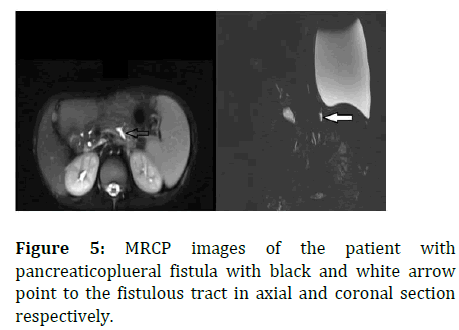
Figure 5: MRCP images of the patient with pancreaticoplueral fistula with black and white arrow point to the fistulous tract in axial and coronal section respectively.
Hidden deep in the upper recesses of the retroperitoneum, the injured pancreas exhibits a spectrum of clinical presentations, from that of occult injury to dramatic exsanguination. Torrential bleeding from the region of the Pancreaticoduodenal Complex (PDC), surging like a crimson tide, is one of the most intimidating sights in trauma surgery. This particularly lethal pancreatic injury is just one of the challenges posed by this unforgiving organ. [4].
Anatomic considerations for pancreas
In cases of traumatic injury, the surgeon often decides the management of the head and the body of the pancreas as two separate entities. The closely related vascular supply and the status of the duct of Wirsung or the main pancreatic duct are the parameters in deciding the course of treatment. Pancreatic body and tail injuries are more readily controlled as compared to the head of the pancreas.
Based on this anatomic arrangement, trauma surgeons view the body and tail of the pancreas as an organ with a single accessible vascular pedicle, similar to the kidney or spleen. When necessary, the injured pancreatic body can be easily resected by performing an en bloc distal pancreatectomy and splenectomy [5].
The head of the pancreas is densely adherent to the duodenal loop and it is convenient to group them together as the PDC. This is because most of the major vascular structures of the upper abdomen converge on a small area, not much larger than a silver dollar around the PDC. [6]. The superior mesenteric vessels, portal vein, Inferior Vena Cava (IVC) and hilum of the right kidney are all in close proximity to the pancreatic head. The vascular structures around the PDC are arranged in three overlapping layers. The deepest one consists of the IVC and right renal pedicle. The vascular arcades around the head of pancreas are more prone to injury in case of a penetrating trauma, rarely are the damaged in case of blunt abdominal trauma [6].
Mechanism of injury
The anatomic location of the pancreas contributes to the low rate of injury. This organ is relatively protected by its deep retroperitoneal location and surrounding organs. Most blunt injuries are caused by deep anterior to posterior intrusive forces compressing the pancreas against the spine, as evidenced by most injuries occurring in the pancreatic body. In adults, steering wheel injuries or lap belt injuries from cranial malpositioning are common. Handlebar injuries and non-accidental trauma are relatively unique to the paediatric population. In penetrating trauma, the tract and depth of penetration often predict the likelihood of pancreatic injury [7]. In the present study the mode of injury was more prevalently due to bicycle handlebar trauma in younger population and the adult population showed various modes of trauma such as bull horn injury and road traffic accident associated trauma.
Clinical picture
Patients with blunt abdominal trauma will present with vague symptoms. Symptoms of radiating epigastric pain to the back, nausea and vomiting are also seen with the more commonly injured adjacent viscera. An abdominal exam is reported to have a false negative rate of 34% on initial evaluation. [2] As the signs and symptoms are nonspecific, a high index of suspicion is necessary to prevent delayed diagnosis. In present series the patients had early as well as late presentation following pancreatic trauma, 3 (60%) cases presented after a minimum of 14 days of pancreatic trauma and the remaining two had a more acute presentation. In the series two thirds of the late presenting cases were hemodynamically stable whereas one patient presented with septic shock.
Investigative approach
Laboratory testing is rarely helpful. Serum lipase and amylase are not specific or sensitive for pancreatic injury; even in complete transection or fracture of the pancreas, amylase levels are normal in 30% to 35% of patients. [8] Therefore there is a reliance on the radiological evaluation and findings of the trauma patients. An abdominal CT is the most sensitive and specific investigation for the diagnosis of visceral and vascular injury. CT represents the gold standard imaging technique for evaluating pancreatic trauma. Variable sensitivity and specificity values have been reported in the medical literature with an overall sensitivity in detecting all grades of pancreatic lesions of about 80% (Table 2) [9].
| Grade | Injury | Description |
|---|---|---|
| Grade I | Hematoma | Minor contusion without duct injury |
| Laceration | Superficial laceration without duct injury major contusion without duct injury | |
| Grade II | Hematoma | Minor contusion without duct injury |
| Laceration | Major laceration without duct injury or tissue loss | |
| Grade III | Laceration | Distal transection or parenchymal injury with duct injury |
| Grade IV | Laceration | Proximal transection or parenchymal injury involving the ampulla or bile duct |
| Grade V | Disruption | Massive disruption of the pancreatic head |
Table 2. AAST scoring system for pancreatic injury.
The American Association for the Surgery of Trauma (AAST) proposed a grading system mainly based on the site of pancreatic trauma and the integrity of the main pancreatic duct. In fact, a CT grading system has been established for supporting the surgical classification [9].
MRCP (Magnetic Resonance CholangioPancreatography) is used as a problem-solving tool for noninvasive assessment of MPD (Main Pancreatic Duct) integrity or to better define parenchymal injury, typically in hemodynamically stable patients who have equivocal CT findings or negative initial CT findings but high clinical suspicion for pancreatic injury. MRCP can depict the MPD in the pancreatic body in up to 97% of cases and in the pancreatic tail in up to 83% of cases [10]. Secretin-stimulated MRCP can depict not only MPD injury but also continued leakage from the MPD, including leaks beyond areas of obstruction that cannot be assessed with ERCP [11].
Endoscopic Retrograde Cholangiopancreatography (ERCP) is a specialized procedure that combines endoscopy and radiological fluoroscopy techniques and is an important test for the diagnosis and treatment of various biliary tract and pancreatic diseases. ERCP was indicated for both therapeutic and diagnostic purposes. Therapeutically, it was performed in cases where there was a suspicion of pancreatic duct injury based on radiologic imaging, such as CT and US.
Diagnostically, it was used when there was uncertainty regarding the integrity of the pancreatic duct observed in radiologic imaging or in cases of clinically suspected pancreatic injury [12]. ERCP is regarded as a gold standard for diagnosing pancreatic duct injury since the specificity is very high and it has the advantage that therapeutic intervention can be performed simultaneously [12]. In the present case series, all the patients underwent a CECT of the abdomen and were graded accordingly. Only one patient with the complication of pancreaticopleural fistula required MRCP for the ductal delineation.
Patients with pancreatic injury were historically associated with high mortality even after timely diagnosis and treatment because of the surgical interventions posing a high degree of morbidity as well as mortality. Therefore, advent of ERCP as a therapeutic modality was a welcome change, ERCP has the advantage of avoiding surgery with the potential risk of splenectomy and even if surgery is necessary it enables surgeons to quickly determine that surgical treatment is necessary and to determine the appropriate type of surgery by locating the exact injured area. [12]. Two (40%) of the patients in the present series were managed conservatively by ERCP guided MPD stenting.
Surgical management hugely depends on the patient's condition. The trauma literature of the 1970s and 1980s is replete with descriptions of pancreas-preserving techniques for complete pancreatic transections with the most popular of these was anastomosis of the distal pancreatic stump to a Roux-en-Y loop of jejunum to create a pancreatojejunostomy [13]. The pancreas preserving procedures were preferred in stable patients. Distal pancreatectomy is often performed in unstable patients with associated injuries, which is not the time for splenic preservation [14]. Vascular injuries usually occur in the context of multiple injuries to the PDC and adjacent structures. Damage control solutions, rather than definitive repairs, are the rule in these situations, because the exsanguinating patient is racing toward a lethal physiologic insult. It is far better to stop the bleeding, close the holes in the bowel and drain the entire area than to attempt a complex visceral reconstruction in an unstable, coagulopathic patient. Reconstruction of the anatomy can safely be done 36 to 48 hours after completion of resuscitation in the intensive care unit. [15]. Traumatic pancreatitis may go unnoticed in the absence of abdominal symptoms and signs. It requires a high index of suspicion, adequate imaging along with pleural fluid analysis to establish the diagnosis. Long‐standing PPF results in the formations of adhesions in pleural cavity and entrapment of the lung. VATS adhesiolysis is the treatment of choice in these cases [16].
Isolated pancreatic trauma is a rare entity and requires high clinical suspicion in patients with blunt abdominal trauma. Patients can have early or late presentation depending on the symptoms. Patients once identified should be investigated thoroughly to avoid any undue complications and to decide the appropriate treatment modality. CECT is sufficient for AAST-OIS grading the injury and to rule out any other traumatic injuries. MRCP and CECT are used for diagnosis and grading the injury. Gold standard for direct visualisation of the duct is still ERCP. It does offer a simultaneous diagnostic and therapeutic option in stable patients in whom ERCP guided stenting is the definitive management. The indication of surgical management is unstable patients and patients who are not responding to conservative management. For the best possible outcome cautious patient selection for appropriate modality of treatment is required. Keeping in mind the patient's condition and pancreatic anatomy. A higher grade of non-bleeding pancreatic injury can be managed conservatively as opposed to undue surgical intervention and morbidity.
[Crossref] [Google Scholar] [PubMed]
[Google Scholar] [PubMed]
[Crossref] [Google Scholar] [PubMed]
[Google Scholar] [PubMed]
[Crossref] [Google Scholar] [PubMed]
[Crossref] [Google Scholar] [PubMed]
[Crossref] [Google Scholar] [PubMed]
[Crossref] [Google Scholar] [PubMed]
[Crossref] [Google Scholar] [PubMed]
[Crossref] [Google Scholar] [PubMed]
[Crossref] [Google Scholar] [PubMed]
[Crossref] [Google Scholar] [PubMed]
Citation: Bakhshi GD, Jadhav KV, Thombare AA, Rajalakshmi V, Boricha SD, Hande M, Choudhari R, Kishore R, Ahire P. To Explore or Not to Explore: Management of Isolated Pancreatic Injury following Blunt Trauma to the Abdomen in a Tertiary Care Centre: A Retrospective Case Series. JOP. J Pancreas. (2024) 25:893.
Copyright: This is an open access article distributed under the terms of the Creative Commons Attribution License, which permits unrestricted use, distribution, and reproduction in any medium, provided the original work is properly cited.